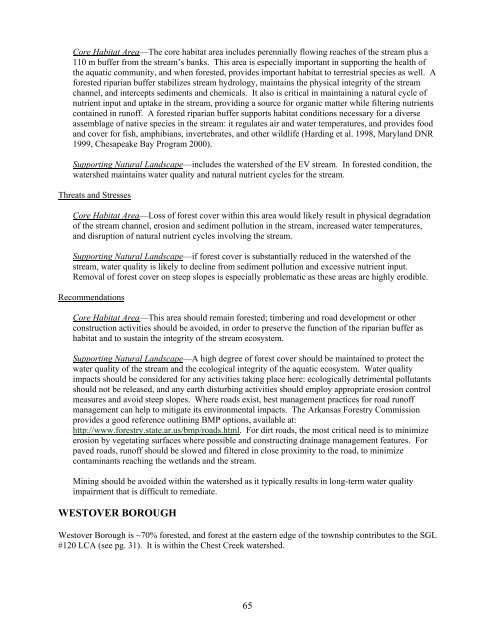introduction - Pennsylvania Natural Heritage Program
introduction - Pennsylvania Natural Heritage Program
introduction - Pennsylvania Natural Heritage Program
Create successful ePaper yourself
Turn your PDF publications into a flip-book with our unique Google optimized e-Paper software.
Core Habitat Area—The core habitat area includes perennially flowing reaches of the stream plus a110 m buffer from the stream’s banks. This area is especially important in supporting the health ofthe aquatic community, and when forested, provides important habitat to terrestrial species as well. Aforested riparian buffer stabilizes stream hydrology, maintains the physical integrity of the streamchannel, and intercepts sediments and chemicals. It also is critical in maintaining a natural cycle ofnutrient input and uptake in the stream, providing a source for organic matter while filtering nutrientscontained in runoff. A forested riparian buffer supports habitat conditions necessary for a diverseassemblage of native species in the stream: it regulates air and water temperatures, and provides foodand cover for fish, amphibians, invertebrates, and other wildlife (Harding et al. 1998, Maryland DNR1999, Chesapeake Bay <strong>Program</strong> 2000).Supporting <strong>Natural</strong> Landscape—includes the watershed of the EV stream. In forested condition, thewatershed maintains water quality and natural nutrient cycles for the stream.Threats and StressesCore Habitat Area—Loss of forest cover within this area would likely result in physical degradationof the stream channel, erosion and sediment pollution in the stream, increased water temperatures,and disruption of natural nutrient cycles involving the stream.Supporting <strong>Natural</strong> Landscape—if forest cover is substantially reduced in the watershed of thestream, water quality is likely to decline from sediment pollution and excessive nutrient input.Removal of forest cover on steep slopes is especially problematic as these areas are highly erodible.RecommendationsCore Habitat Area—This area should remain forested; timbering and road development or otherconstruction activities should be avoided, in order to preserve the function of the riparian buffer ashabitat and to sustain the integrity of the stream ecosystem.Supporting <strong>Natural</strong> Landscape—A high degree of forest cover should be maintained to protect thewater quality of the stream and the ecological integrity of the aquatic ecosystem. Water qualityimpacts should be considered for any activities taking place here: ecologically detrimental pollutantsshould not be released, and any earth disturbing activities should employ appropriate erosion controlmeasures and avoid steep slopes. Where roads exist, best management practices for road runoffmanagement can help to mitigate its environmental impacts. The Arkansas Forestry Commissionprovides a good reference outlining BMP options, available at:http://www.forestry.state.ar.us/bmp/roads.html. For dirt roads, the most critical need is to minimizeerosion by vegetating surfaces where possible and constructing drainage management features. Forpaved roads, runoff should be slowed and filtered in close proximity to the road, to minimizecontaminants reaching the wetlands and the stream.Mining should be avoided within the watershed as it typically results in long-term water qualityimpairment that is difficult to remediate.WESTOVER BOROUGHWestover Borough is ~70% forested, and forest at the eastern edge of the township contributes to the SGL#120 LCA (see pg. 31). It is within the Chest Creek watershed.65










